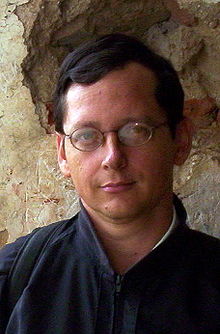Julian Monge Najera
| Julián Monge-Nájera | |
|---|---|
 |
|
| Born |
6 June 1960 San José, Costa Rica |
| Nationality | Costa Rica |
| Fields | Ecologist, Evolutionary biology, History of Science, Distance Education, Art Photography |
| Alma mater | Universidad de Costa Rica |
| Known for | Scientific Adviser to the BBC (Sir David Attemborough's Trials of Life and Life in the Undergrowth) and the National Geographic Society, Member, Biogeography Society, Paris, Director University of Costa Rica Press. |
Julián Monge-Nájera (born June 6, 1960 in San José is a Costa Rican ecologist, scientific editor, educator and photographer. He has done research with the following institutions: Universidad de Costa Rica, Smithsonian Tropical Research Institute, and Universidad Estatal a Distancia. His scientific work has been featured by The New York Times;National Geographic Magazine;the BBC; Wired; IFLoveScience; The Independent (London) and The Reader's Digest, among others. He is a member of the Expert Panel that sets the Environmental Doomsday Clock; Onychophora Curator in the Encyclopedia of Life; and Team Member of the IUCN Red List of Threatened Species.
Monge-Nájera was the Editor of Revista de Biología Tropical/International Journal of Tropical Biology and Conservation for more than 30 years, but simultaneously published nearly 200 scientific articles and more than 20 books on a variety of biological topics and other areas.
Early research focused on tropical freshwater turtles but soon Monge-Nájera moved to freshwater snails (Physidae). He described the vertical movements of the snails in the water column, embryo development and the presence of internal trematode parasites and of oligochaete worms on the snails' body surface. His study of invertebrate ecology always centered on the evolutionary origin of adaptations that allowed mollusks, velvet worms, and insects to inhabit particular places. After his early study of freshwater snails, he turned to terrestrial snails and how they could become agricultural pests after their original forests habitats, where they were rare, were cut down. Monge-Nájera's book on how to control terrestrial and aquatic mollusks of agricultural and medical importance has long been the only one available for tropical species. He published a detailed study on Hamadryas butterflies that analyzed their use of trees as territories and the why and how of sound production. This study solved some questions that had been made but left unanswered by Charles Darwin in his Journal of Researches and in The Descent of Man and Selection in Relation to Sex. His discoveries with butterflies were mentioned in National Geographic Magazine and The Readers' Digest With several colleagues he summarized previous knowledge on sound production by butterflies and described the basic ecology and field behavior of several species. With H.F. Swanson, he reported that daily records of the Red Admiral butterfly (Vanessa atalanta) taken for more than 8000 consecutive days identified demographic patterns that can be missed in studies with less detailed observations. In a copublication with I. Hedström, Monge-Nájera also found that larger fruit flies, which appear to have more sexual partners, are more frequently infected by sexually transmitted fungi. With Ramírez and Chavarría, he found that fig wasps follow simple rules instead of complex calculations when defining the sex of offspring. His work with Z. Barrientos found that even though the individual species change, the guild distribution within insect communities is similar among highland paramos of several countries, paralleling a phenomenon previously recorded in marine islands.
...
Wikipedia
